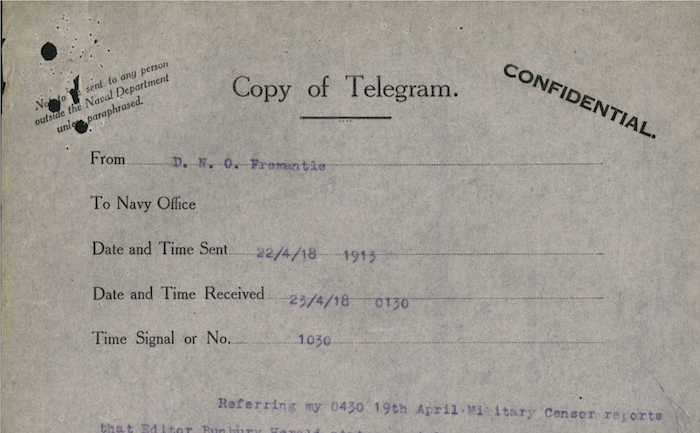
NAA: MP1049/1, 1918/066, page 416 is a report from Lieutenant Commander George D. Warren RANR, commanding officer, HMAS Coogee, a civilian coastal steamship requistioned by the Navy for use as a minesweeper. Warren is reporting on the results of his investigation of an aeroplane seen from a naval lookout on the northern end of King Island, a large island in Bass Strait, between Victoria and Tasmania. This was seen back on 1 November, first one (NAA: MP1049/1, 1918/066, page 426):
Aeroplane sighted 3 50pm to day Victorian time steering south easterly direction skying [sic] very low distance away unc[e]rtain about 7 miles fairly strong wind blowing.
A second report gives a different time (NAA: MP1049/1, 1918/066, page 424):
aeroplane sighted 4.50 p.m. north east flying south east lost in clouds 4.58 p.m.
In fact this was originally interpreted as a second aeroplane, but the near-identical descriptions combined with the difference of an hour exactly suggests that this confusion resulted from the new institution of daylight savings time, in force on this date in Tasmana, to which King Island belongs, but not in Victoria, for some reason used as the time reference in the first report.
However, on 4 November the Navy Office was still under the impression that there had been two aeroplanes seen at King Island, sending an urgent request for more information about both of them as well as a ship seen earlier (NAA: MP1049/1, 1918/066, page 422). D Station replied that (NAA: MP1049/1, 1918/066, page 420):
No noise heard as wind was S.E. plane seen N.E. approximately five to seven miles distant flying low plane too far off to discern number personssingle [sic] wings fore cigar shaped body painted dark color [sic]; steamer about five hundred tons supposed Hilmeade.
Coogee was ordered to proceed to King Island that same day (NAA: MP1049/1, 1918/066, page 419). On 10 November it reported from Burnie on the Tasmanian coast (NAA: MP1049/1, 1918/066, page 417):
Arrived from King Island yesterday [10 November 1918] investigated report of aeroplanes night firing seen from south end Island proceeding Flinders and neighbouring islands searching. Please inform Navy Office, Melbourne.
The aeroplanes plural here could be another (or the same) mistake, but now they are said to have been seen at ‘night’ rather than the late afternoon, and, remarkably, ‘firing’. Both of these words are confirmed by an underline, which according to a legend on an earlier (but garbled) copy of this telegram means ‘Correctly decoded’ after initially being read as ‘night flying’ (NAA: MP1049/1, 1918/066, page 418).
However, writing a week later, Warren’s final report doesn’t mention anything about ‘night firing’:
I have to report that on arrival at Surprise Bay, south end of King Island, a party was landed and visits were paid to ‘E’ Lookout Station and farms in the vicinity with a view to ascertaining if any aeroplanes had been seen or heard at any time during the last 4 weeks, in every case after close questioning and investigation a negative answer was given so that apparently if the statement from the northern Station was accurate, the reported aeroplanes must have turned off and proceeded oversea to Tasmania or Flinders Island. At both Islands inquiry was made and written reports handed in but in neither of the Islands had anything been seen or heard of aeroplanes in the vicinity.
What is surprising about this incident — and is the reason why I cited it in my article — is not only that this is so late in the mystery aeroplane panic, half a year since the main wave of reports died out, but that it’s so close to the end of the war itself. In fact, adjusting for the time difference, Coogee must have sent its report from Burnie not far short of the guns falling silent in Europe. When the aeroplane was spotted at D Lookout, armistice negotiations were already being reported in the press. This final report was submitted a week after it was all over. So why bother? My guess would be that it was precisely because of the end of the war being imminent which made this a moment of tension, when it was just possible that something could go terribly wrong. Perhaps German last-ditchers would make some kind of a final lunge at victory? Maybe the Kaiser’s spies would decide to go out in a blaze of glory? Or might that untrusted ally Japan take this moment to launch a surprise attack? Whatever the reason, that was the end of that.
![]() This work is licensed under a Creative Commons Attribution-NonCommercial-NoDerivatives 4.0 International License.
Permissions beyond the scope of this license may be available at http://airminded.org/copyright/.
This work is licensed under a Creative Commons Attribution-NonCommercial-NoDerivatives 4.0 International License.
Permissions beyond the scope of this license may be available at http://airminded.org/copyright/.





